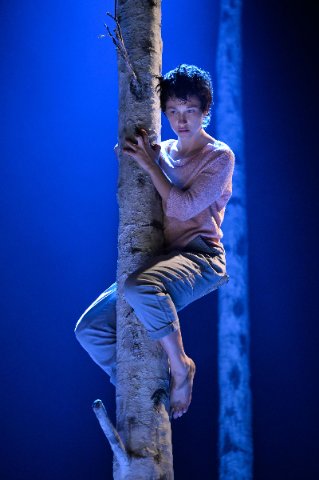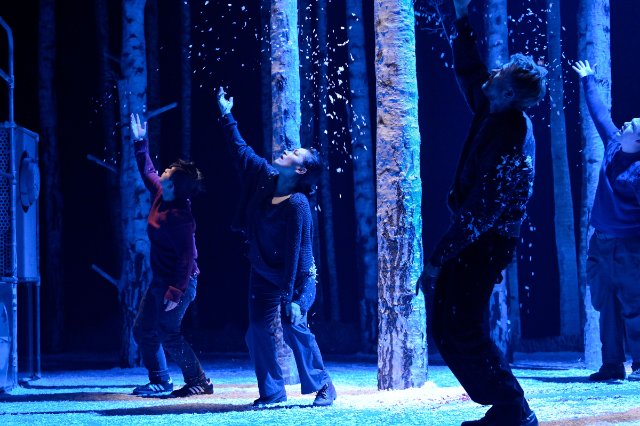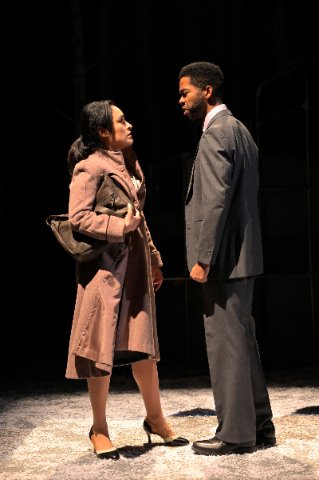Let The Right One In
Intelligent Vampire Story With Interesting Twists But Inconsistent Tone.
By: Victor Cordell - May 26, 2023
Some people would argue that one can’t reach potential unless willing to leave their comfort zone. This reviewer has little taste for the vampire genre and less for violence, but what better time to break out of the shell than to witness a production of noted author Jack Thorne’s “Let The Right One In,” produced by the estimable National Theatre of Scotland and presented by the estimable Berkeley Repertory Theatre?
Let it be said that the opening night crowd, younger and more fashionable than a typical graying Berkeley Birkenstock crowd, fairly gushed at the performance, and most colleagues who I spoke with enjoyed it. So, take this not fully enthused critique as a minority opinion. The good news is that even a detractor can find much to like. One particular strength of the play is that it opens many avenues for symbolic interpretation and post-hoc discussion, which is worth the price of admission. Another is that the production values show well.
Rather than a simple blood-sucking horror, the play focuses largely on the relationship between Oskar, a bullied teenage boy from a broken home with a drunken mother and a largely neglectful father, and Eli, a new neighbor - who possesses an androgynous look; acts mostly like a girl; but insists that she’s not a girl, with no further explanation. Eli sometimes moves with tomboy athleticism and other times with the hunched wobbling of a grounded bat. Of course, she’s a vampire and in this telling, without gender. Despite appearances, Eli is several hundred years old.
For all their differences, the relationship between these two oddities can be seen as a teenage love story. Another overarching theme is that of coming-of-age for Oskar, as he embarks on his first romance and screws up his courage to fight back against the bullies at Eli’s urging. More broadly, the story signifies the pervasiveness of teen angst. Finally, a strong undercurrent of co-dependency is evidenced, most significantly between Oskar’s mother and Oskar; Eli and “her” “father figure"/”boyfriend;” and the bully boys.
As vampire stories go, this one doesn’t particularly frighten, though one incident with sudden shrieking sound and bright light gives a shock. And while the opening scene is gory and would seem to portend more of the same, the plot offers more intelligence and depth, dealing with numerous relationship clashes among the characters and suggesting the friction that we all confront in life.
A certain eeriness does derive from the staging, starting with Christine Jones’s scenic design. Although most of the action could be presented in conventional homes, schools, and hospitals, Jones’s fixed stage consists of a forest of birch tree trunks shorn of all but stubs of branches. This setting of nature’s overwhelming power induces a sense of tension and fear of the unknown crucible. Moveable props such as a bed, a couch, or a steamer trunk are brought in as needed to represent interiors, but always with the foreboding forest as a backdrop. A seeming anomaly in the forest is a large metal contraption that operates mostly like a jungle-gym for Eli but has a surprise and meaningful use near the conclusion when Oskar is trapped by bullies.
Chahine Yavroyan’s low lighting with generous use of spots adds to the unsettling ambiance and a sense of isolation, while Gareth Fry’s sound design also disturbs. Director John Tiffany has integrated all of these creative elements into an effective whole.
So what elements might be less satisfying in this reviewer’s opinion? As an action story, “Let The Right One In” lacks driving pace. Tension is allowed to slack too often, especially with the several choreographed dances, which on their own are very artistically designed and executed. However, they disrupt the dramatic tone and impede the action. Several main characters are teenagers, and they are played with teen affect. While these depictions may be an appropriate representation of reality, the effect is that they give an impression of being less professionally acted and less convincing. This is despite the fact that Diego Lucano aptly portrays the anxiety and gawkiness of Oskar, and Noah Lamanna beautifully conveys the contrasts and ambiguities of Eli’s bimodal personality – as an ersatz youth with a need to fit in as a human and as a voracious vampire with a need to survive. Finally, there is no doubt that the author could explain how each scene contributes to the vital force of the narrative, but some appear to be a stretch and don’t add to the plot engine. For instance, the candy store scenes may depict compassion and lead to demonstrating how vampires can’t eat people food, but they seem superfluous. Oskar’s beating his father in checkers may demonstrate competitive dominance behavior, but it seems strange having Oskar as the dominator.
All told, this play possesses an abundance of quality and some interesting aspects. It will appeal to a broad audience that can appreciate the vampire genre being lifted to a higher intellectual plane.
“Let The Right One In” is written by Jack Thorne, based on the novel and film by John Ajvide Lindqvist, is produced by National Theatre of Scotland, presented by Berkeley Repertory Company, and plays on its stage at 2025 Addison Street, Berkeley, CA through June 25, 2023.







